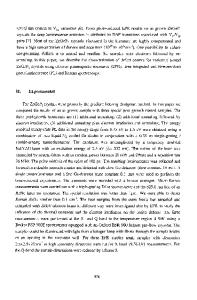Native Point Defect Densities and Dark Line Defects in ZnSe
- PDF / 344,657 Bytes
- 5 Pages / 414.72 x 648 pts Page_size
- 15 Downloads / 381 Views
Schr~dinger equation is solved for the full potential inside spheres surrounding each nucleus and centered at the tetrahedral interstitial sites. Muffin-tin radii were chosen positioned at each atomic site and at each tetrahedral interstitial site. In the usual manner, supercells involving repeated arrays of defects were used so as to maintain periodic boundary conditions. Supercells containing both 16 and 32 lattice sites were used. For both supercell sizes, the overall lattice constant was allowed to relax. For the 16-site cell, first-neighbor relaxation was included; for the 32-site cell, first and second neighbors were permitted to relax. We have examined eight defects: cation and anion vacancies, cation and anion antisites, and the cation and anion interstitial at both the cation and anion tetrahedral interstitial sites. Unless otherwise noted, we have used the zinc atom in the vapor phase as our reference state for reporting energies; the defect reactions considered and the notation used for the defects
are given in Table I. With few exceptions, gradient corrections (GC)
to the LDA have been found to system-
atically improve the prediction of the cohesive energy in a wide range of materials [4]. The improvement in the cohesive energy is largely due to improvement in the calculation of the total energy of the free atoms, rather than the solid. Here, we are interested in calculating total energies for reactions in which a constituent is exchanged between the solid and the vapor, and thus the errors inherent in the local-density calculation of the cohesive energy will be present in these energies also. Because the relaxations do not change significantly when gradient corrections are added, we have completed the majority of the calculation, including the relaxation, within the FP-LMTO. The gradient correction energy, calculated at the LDA-determined relaxed positions, is then added to the LDA energy.
TABLE I. Defect reactions considered for compound ZnSe. Notation is as follows: The primary symbol refers to the species, the subscript refers to the site that the species occupies, with no subscript indicating that the species is occupying its usual lattice site. V corresponds to a vacancy and I an interstitial; free is the free atom reference state. Two types of interstitials are considered, both occupying tetrahedral sites, the first surrounded by four zinc nearest neighbors, Iz&,and the second surrounded by four selenium nearest neighbors, Ise. All species are neutral. Formation energies reported here have been calculated using 16-atom supercells. Energies for the 32-atom cells are from 0.03 to 0.2 eV larger.
Energy (eV)
Reaction
Defect
LDA Vz. Vsr Znz. Sezn
ZnSe Zn 2Znlfr, 2ZnSe
Znir,
Znre
----
Zn,..
ZnI•,
-
Selh
ZnSe
SeI.
ZnSe
---
-ree --.
-
GC
Total
5.09 0.72 -1.37 9.57
-0.46 0.32 1.00 -1.16
4.63 1.04 -0.37 8.42
1.10
0.32
1.42
1.36
0.26
1.62
Se1 ,, + Znf,r
7.55
-0.75
6.80
Se,•. + Znf,ý.
9.10
-0.85
8.24
Vz, Se + Znffre ZnVsý ZnZn5 Sez,,Se + 2Zn1 ,.ro Zn12 , Znr,.
504
Data Loading...










